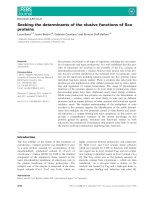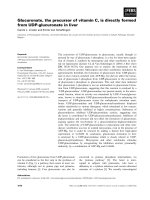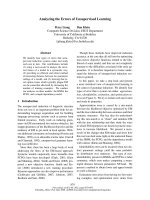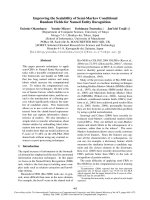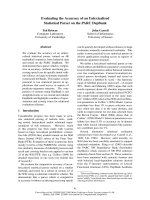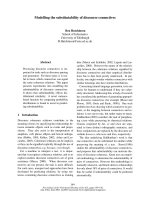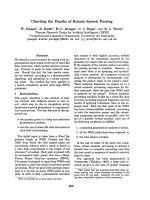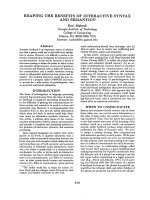Báo cáo khoa học: "Differentiating the impact of anatomic and non-anatomic liver resection on early recurrence in patients with Hepatocellular Carcinoma" pps
Bạn đang xem bản rút gọn của tài liệu. Xem và tải ngay bản đầy đủ của tài liệu tại đây (673.22 KB, 7 trang )
WORLD JOURNAL OF
SURGICAL ONCOLOGY
Eltawil et al. World Journal of Surgical Oncology 2010, 8:43
/>Open Access
RESEARCH
© 2010 Eltawil et al; licensee BioMed Central Ltd. This is an Open Access article distributed under the terms of the Creative Commons
Attribution License ( which permits unrestricted use, distribution, and reproduction in
any medium, provided the original work is properly cited.
Research
Differentiating the impact of anatomic and
non-anatomic liver resection on early recurrence in
patients with Hepatocellular Carcinoma
Karim M Eltawil
1,2
, Mark Kidd
1
, Francesco Giovinazzo
1
, Ahmed H Helmy
2
and Ronald R Salem*
1
Abstract
Background: For Hepatocellular Carcinoma (HCC) treated with hepatectomy, the extent of the resection margin
remains controversial and data available on its effect on early tumor recurrence are very few and contradictory. The
purpose of this study was to compare the impact of the type of resection (anatomic versus non-anatomic) on early
intra-hepatic HCC recurrence in patients with solitary HCC and preserved liver function.
Methods: Among 53 patients with similar clinico-pathologic data who underwent curative liver resection for HCC
between 2000 and 2006, 28 patients underwent anatomic resection of at least one liver segment and 25 patients
underwent limited resection with a margin of at least 1 cm.
Results: After a close follow-up period of 24 months, no difference was detected in recurrence rates between the
anatomic (35.7%) and the non-anatomic (40%) groups in either univariate (p = 0.74) and multivariate (p = 0.65) analysis.
Factors contributing to early recurrence were tumor size (p = 0.012) and tumor stage including vascular invasion (p =
0.009).
Conclusion: The choice of the type of resection for HCC should be based on the maintenance of adequate hepatic
reserve. The type of resection (anatomic vs non-anatomic) was found not to be a risk factor for early tumor recurrence.
Background
HCC is considered the fifth most frequent cancer in the
world and the third most common cause of cancer related
mortality [1]. Although more common in Asia and
Africa, the incidence of HCC is increasing in the Western
world [2]. According to the Surveillance and Epidemiol-
ogy End Results (SEER) registries, the average age
adjusted incidence of HCC in the United States increased
from 1.3 per 100,000 in 1978-1980 to 6.6 per 100,000
based on cases diagnosed in 2002-2006 from 17 SEER
geographic areas [3].
Resection for HCC is a widely accepted safe treatment
with a very low operative mortality as a result of advances
in surgical techniques and peri-operative management
[4]. However, identifying an optimum extent of resection
is often difficult due to underlying liver disease such as
chronic hepatitis or cirrhosis in most patients [5]. Based
on the fact that cirrhotic liver has limited capacity to
regenerate [6], many surgeons perform limited resection
for HCC, focusing on the preservation of 1 cm or greater
tumor-free margin to reduce postoperative liver failure in
patients with cirrhosis [7]. Anatomic liver resection is
theoretically superior to non-anatomic from the onco-
logic and anatomic aspects [8], however, this technique is
considered technically more demanding and often
requires a wider extent of parenchymal sacrifice [4,9].
Additionally, several clinical studies have failed to docu-
ment any improvement in survival [10-12].
The rate of development of postoperative recurrence
after hepatic resection remains high [13]. Early recur-
rence within 2 years of hepatic resection for HCC is likely
to be associated with aggressive tumor biology such as
high tumor grade, satellite lesions and microvascular
invasion [14].
This retrospective study compares the impact of ana-
tomic and non-anatomic resections on early recurrence
in HCC patients over a 2 year period. Other pre and peri-
* Correspondence:
1
Department of Surgery, Yale University School of Medicine, New Haven,
Connecticut, USA
Full list of author information is available at the end of the article
Eltawil et al. World Journal of Surgical Oncology 2010, 8:43
/>Page 2 of 7
operative factors were also evaluated between the two
groups.
Methods
This study was approved by the Human Investigation
Committee (HIC) of Yale University as well as the Ethical
Committee of Theodor Bilharz Research Institute
(TBRI).
Patients
Between 2000 and 2006, 53 patients who had a preopera-
tive diagnosis of a single HCC and who underwent hepa-
tectomy at Yale-New Haven Hospital and TBRI-General
Hospital were included in the study. The pre-operative
investigations included blood chemistry, hepatitis B & C
markers, alpha-fetoprotein (AFP), abdominal ultrasonog-
raphy (US), computed tomography (CT), chest radiogra-
phy with or without liver biopsy based on the diagnostic
criteria of the American Association for the Study of
Liver Diseases (AASLD) [15]. All selected patients had
compensated cirrhosis with Child-Pugh class A/early B
or were non-cirrhotics.
Patient characteristics
The following clinical variables were compared in the two
groups: age, sex, viral markers (Hepatitis B [HB] virus
surface antigen, anti-HB core antibody, anti-HB surface
antibody, hepatitis C virus antibody), presence or absence
of cirrhosis, serum albumin, serum total bilirubin, Child-
Pugh classification and serum AFP (Table 1).
Hepatectomy procedures
The patients were divided into two groups. Anatomic
resection (n = 28) was defined as the complete removal of
at least 1 Couinaud's segment containing the tumor
together with the related portal vein and the correspond-
ing hepatic territory. The appropriate segment margins
were identified by intra-operative US after discoloration
of the parenchyma after ligation of the corresponding
arterial and portal venous branches or both. Non-ana-
tomic resection (n = 25) was defined as the resection of
the tumor with a margin of at least 1 cm without regard
to segmental, sectional or lobar anatomy. There was no
evidence of extra-hepatic metastasis. All patients under-
went intraoperative hepatic ultrasonography and were
deemed to have resectable tumors at the time of surgery.
Patient follow-up
The two patients groups were subjected to a close follow-
up of 2 years. During this period they underwent clinical,
radiologic (abdominal US and triphasic abdominal CT
scan) and biologic (serum AFP and liver function tests)
evaluations. This assessment was repeated every 3
months throughout the follow-up period.
End Points
The main end points of the study were: 1- In-hospital
mortality, morbidity and length of hospital stay. 2- The
detection of early disease recurrence through the 2 year
follow-up period. The impact of the type of resection
(anatomic vs non-anatomic) on early disease recurrence
was studied in the two groups. Other risk factors that
could play a role in early tumor recurrence such as the
tumor size, TNM staging, vascular invasion, pathologic
grading and high AFP values were also assessed.
Statistical analysis
For continuous variables, data are presented as mean +/-
Standard Deviation (SD). Group comparisons were per-
formed using univariate analysis (chi-square test or the
student t test as appropriate). For multivariate analysis,
different factors were correlated with early tumor recur-
rence, and the SPSS Statistical Software (SPSS 16.0, Chi-
cago, IL) was used for these calculations. Survival (24
Table 1: Pre-operative demographic data
Variable Anatomical Non-Anatomical p
Age (yr) 62.18 +/- 12.09 57.4 +/- 11.06 ns
Sex (M/F) 21/7 18/7 ns
HBV (y/n) 7/21 5/20 ns
HCV (y/n) 11/17 11/14 ns
HBV+HCV (y/n) 3/25 5/20 ns
Cirrhosis (y/n) 8/20 10/15 ns
Serum albumin (gm/dl) 3.76 +/- 0.34 3.84 +/- 0.37 ns
Serum bilirubin (mg/dl) 0.86 +/- 0.15 0.87 +/- 0.28 ns
Child-Pugh (A/B) 23/5 21/4 ns
AFP (>25/<, = 25) 6/22 9/16 ns
HBV: Hepatitis B virus; HCV: Hepatitis C virus; AFP: Alphafetoprotein; ns: Not significant
Eltawil et al. World Journal of Surgical Oncology 2010, 8:43
/>Page 3 of 7
months) was calculated using the Kaplan-Meier method
(Deltagraph 4.0). A P value < 0.05 was considered signifi-
cant.
Results
There was no difference detected between the 2 groups in
terms of clinical and demographic characteristics with
respect to age, sex, viral hepatitis markers, and the pres-
ence of underlying liver cirrhosis, serum albumin, serum
bilirubin, Child-Pugh classification and AFP levels (Table
1).
The tumor pathologic grades were not significantly dif-
ferent between the two groups with only a single poorly
differentiated tumor in each group (3.5% of the anatomic
group and 4% of the non-anatomic). Two patients in the
anatomic group presented with fibrolamellar HCC (FL-
HCC) which is a rare variant of HCC that has relatively
indolent tumor biology and may carry a better prognosis
after complete resection [16].
Using univariate analysis methods, no difference was
detected between the two groups in terms of tumor stag-
ing. Vascular invasion (T3) occurred in 9 patients in the
anatomic group (32.1%) and 7 patients in the non-ana-
tomic group (28%). Nodal involvement occurred in 2
patients in the anatomic group (7.1%) and one patient in
the non-anatomic group (4%)(Table 2). Diaphragm
involvement requiring resection occurred in a single
patient in the anatomic group.
The overall morbidity was not statistically significant
between anatomic and non-anatomic resections (21.4%
vs 28%). This was mainly due to respiratory complica-
tions; atalectasis and occasionally respiratory distress.
Other morbidities included wound infections, urinary
tract infections and intra-abdominal collections which
required ultrasound guided drainage. The 30-day mortal-
ity rates were not significant between the 2 groups (p =
0.48). The three overall mortalities were caused by pul-
monary embolism, liver failure and portal hypertension
respectively. One occurred in the anatomic group and the
other 2 were in the non-anatomic group.
Hospital stay was significantly different between the
anatomic and non-anatomic groups (6.9 +/- 1.5 vs 9.6 +/-
2.7) with a p value of 0.0004. This difference is attributed
to the surgeon preference as the majority of the non-ana-
tomic resections were performed in TBRI-General Hos-
pital where patients are customarily observed in hospital
for longer periods of time. All operative and peri-opera-
tive outcomes are shown in (Table 2).
The majority of anatomic resections (85.7%) were per-
formed at Yale-New Haven Hospital while 84% of the
non-anatomic resections were performed at TBRI Gen-
eral Hospital (p = 0.001) (Table 2). The tumor size & site,
the presence of underlying liver cirrhosis and the sur-
geon's experience are the main factors based on which
the type of resection was decided.
Early tumor recurrence and possible predisposing factors
Using the univariate analysis method, there was no differ-
ence between the 2 groups in terms of recurrence
through the 24 months follow-up period. The recurrence
rate was 35.7% in the anatomic group and 40% in the non-
anatomic (p = 0.74). This suggests that the type of resec-
tion did not have an impact on early recurrence in HCC
patients undergoing liver resection (Figure 1).
Factors affecting early tumor recurrence
Multivariate analysis was undertaken to correlate preop-
erative demographic data, tumor biologic data and opera-
tive variables with early tumor recurrence through the 24
months follow-up period in 50 patients after excluding
the three early post-operative mortalities (Table 3). To
clarify the predictors of early tumor recurrence after
hepatectomy, 14 clinicopathologic parameters were ana-
lyzed. As a result, variables that affected early recurrence
were maximal tumor diameter (Correlation Coefficient
[CC] = 0.354; p = 0.012) and the tumor T stage which
included, in addition to the tumor size, the presence of
microscopic vascular invasion as a parameter of the T3
stage [17] (CC = 0.366; p = 0.009). The hepatectomy pro-
cedure (anatomic vs non-anatomic did not affect early
recurrence either in the univariate (p = 0.74) or in the
multivariate analysis (CC = -0.066; p = 0.651).
Discussion
HCC has recently gained major clinical interest because
of its increasing incidence worldwide and the potential to
diagnose and treat the disease at an early stage [18-20].
Although liver transplantation has proven to be an alter-
native option for the surgical management of HCC in cir-
rhotic patients, its use is limited by the shortage of donors
[21]. Hepatic resection remains the treatment of choice
offering the possibility of cure, but the long-term progno-
sis remains unsatisfactory due to the high recurrence rate
[22-24]. Early recurrence is considered one of the most
important factors that impact the prognosis of HCC
patients [25].
The present study attempts to determine the impact of
the type of liver resection (anatomical vs. non-anatomi-
cal) on early intrahepatic tumor recurrence in a group of
patients with solitary HCC. The patients were similar in
preoperative clinical characteristics and tumor biology.
The study showed through close follow-up over a 24
months period that the type of resection is not consid-
ered a risk factor for early tumor recurrence. On the
other hand, other factors such as tumor size and micro-
scopic vascular invasion affected early recurrence. High
Eltawil et al. World Journal of Surgical Oncology 2010, 8:43
/>Page 4 of 7
levels of AFP were not shown to have an impact on early
recurrence.
Recent studies have shown that the prognosis of recur-
rent HCC after resection depends on the time of recur-
rence, supporting the hypothesis that recurrent tumors
are subclinical metastases, originating from the primary
tumor and missed during treatment (early recurrence), or
de novo HCC arising from persistent fibrosis and hepati-
tis related carcinogenicity in the remnant liver (late
recurrence) [26-28]. In these studies, early recurrence
was associated with adverse tumor factors, especially vas-
cular invasion, whereas late recurrence was reported to
be primarily associated with the presence of cirrhosis.
From these studies, only one study by Imamura et al. [27]
included the type of resection as a possible risk factor for
early recurrence. They concluded that non-anatomic
resection is considered a risk factor for early recurrence.
However, in this study non-anatomic resection was clas-
sified into tumor enucleation and limited resection. The
resection margin was not identified in the resection
group. In our study all patients undergoing non-anatomic
resection had a 1 cm clear margin. A recent study by Cuc-
chetti et al [29] compared different risk factors for early
and late recurrence in cirrhotic HCC patients. They con-
cluded that the type of resection (anatomical vs limited)
is not considered a risk factor for early tumor recurrence
which coincides with the results of our study. Although
this study considered high AFP levels a risk factor for
Table 2: operative variables and peri-operative outcomes
Variable Anatomical Non-Anatomical P
Grade (differentiation)
- Well diff.
11 (39.2%) 15 (60%) ns
- Moderately diff. 14 (50%) 9 (36%) ns
- Poorly diff. 1 (3.5%) 1(4%) ns
- Fibrolamellar 2 (7.1%) 0 ns
TNM Stage: T1 3 (10.7%) 1 (4%) ns
T2 13(46.4%) 17 (68%) ns
T3(vascular invasion) 9 (32.1%) 7 (28%) ns
T4 2 (7.1%) 0 ns
N+ 2 (7.1%) 1 (4%) ns
Tumor size 5.9 +/- 2.8 4.1 +/- 1.7 0.02
Hospital stay 6.9 +/- 1.5 9.6 +/- 2.7 0.0004
Morbidity 6 (21.4%) 7 (28%) ns
Mortality 1 (3.5%) 2 (8%) ns
Recurrence 10 (35.7%) 10 (40%) ns
Yale/TBRI 24/4 4/21 0.001
Diff.: differentiated. T1: single tumor < 2 cm without vascular invasion, T2: single tumor > 2 cm without vascular invasion, T3: solitary tumor
>2 cm with vascular invasion, T4: tumor involving a major branch or portal or hepatic vein. N: nodal involvement. M: metastasis[17]
Eltawil et al. World Journal of Surgical Oncology 2010, 8:43
/>Page 5 of 7
early recurrence, we attribute this to different cut-off val-
ues used for high AFP (60 ng/ml vs 25 ng/ml).
While some authors have found anatomic resection to
have a beneficial effect on recurrence-free survival for
HCC [30], others have found that anatomic and non-ana-
tomic resection had no significant impact on the risk of
tumor recurrence [8,31,32]. These studies were based on
overall long-term survival and therefore early and late
recurrence risk factors were not taken into consideration.
While some centers pursue a policy of performing non-
anatomical hepatic resections whenever possible in order
to decrease the rate of postoperative hepatic failure [33],
in our study only one patient died from hepatic failure
during the early postoperative period. Larger studies may
be required to investigate the incidence of post-operative
hepatic decompensation following non-anatomic resec-
tion.
Figure 1 comparison of intrahepatic recurrence rates between
the anatomic and non-anatomic groups through the 24 months
follow-up period.
Table 3: Multivariate analysis table correlating risk factors to tumor recurrence using the SPSS Statistical Software.
Recurrence
Risk Factors Correlation Coefficient p Number
Age 0.001 ns 50
Sex -0.074 ns 50
HBV 0.083 ns 50
HCV 0.016 ns 50
HBV+HCV 0.089 ns 50
Cirrhosis -0.017 ns 50
Total Bilirubin -0.248 ns 50
Serum Albumin 0.058 ns 50
Child-Pugh A 0.176 ns 50
Abnormal AFP 0.178 ns 50
Tumor max. diameter 0.354 0.012 50
T stage 0.366 0.009 50
N stage 0.138 ns 50
Anatomical resection -0.066 ns 50
Eltawil et al. World Journal of Surgical Oncology 2010, 8:43
/>Page 6 of 7
A recent study by Yoshioka et al. [34] predicted early
recurrence in HCC after radical resection based on whole
human gene expression profiling using microarray analy-
ses. This study concluded that gene expression pattern
related to early intrahepatic recurrence inherited in pri-
mary HCC can be used for the prediction of prognosis.
Although our analysis focused on clinical factors affect-
ing early tumor recurrence mainly the type of resection,
further studies based on genetic analysis may provide
more evidence regarding the origins of recurrent tumors.
Conclusion
Hepatic resection for HCC is a balance between the
extent of resection and the preservation of hepatic func-
tion. The results of this study show that the type of resec-
tion (anatomic vs non-anatomic) is not considered a
distinct risk factor for early (2 year) tumor recurrence in
patients with solitary HCC and preserved liver function.
Other factors such as tumor size, staging and pathologic
characteristics should be considered predictors of early
tumor recurrence.
Competing interests
The authors declare that they have no competing interests.
Authors' contributions
All authors have read and approved the manuscript.
Author Details
1
Department of Surgery, Yale University School of Medicine, New Haven,
Connecticut, USA and
2
Department of Surgery, Theodor Bilharz Research
Institute, Cairo, Egypt
References
1. Kamangar F, Dores GM, Anderson WF: Patterns of cancer incidence,
mortality, and prevalence across five continents: defining priorities to
reduce cancer disparities in different geographic regions of the world.
J Clin Oncol 2006, 24:2137-50.
2. Parkin DM, Bray F, Ferlay J, Pisani P: Estimating the world cancer burden:
Globocan 2000. Int J Cancer 2001, 94:153-6.
3. The US National Cancer Institute. Surveillance Epidemiology and End
Results (SEER) data base 2007 [ />4. Fan ST, Lo CM, Liu CL, Lam CM, Yuen WK, Yeung C, Wong J: Hepatectomy
for hepatocellular carcinoma: toward zero hospital deaths. Ann Surg
1999, 229:322-30.
5. Makuuchi M, Imamura H, Sugawara Y, Takayama T: Progress in surgical
treatment of hepatocellular carcinoma. Oncology 2002, 62(Suppl
1):74-81.
6. Yamanaka N, Okamoto E, Kawamura E, Kato T, Oriyama T, Fujimoto J,
Furukawa K, Tanaka T, Tomoda F, Tanaka W: Dynamics of normal and
injured human liver regeneration after hepatectomy as assessed on
the basis of computed tomography and liver function. Hepatology
1993, 18:79-85.
7. Takano S, Oishi H, Kono S, Kawakami S, Nakamura M, Kubota N, Iwai S:
Retrospective analysis of type of hepatic resection for hepatocellular
carcinoma. Br J Surg 2000, 87:65-70.
8. Tanaka K, Shimada H, Matsumoto C, Matsuo K, Nagano Y, Endo I, Togo S:
Anatomic versus limited nonanatomic resection for solitary
hepatocellular carcinoma. Surgery 2008, 143:607-15.
9. Torzilli G, Makuuchi M, Inoue K, Takayama T, Sakamoto Y, Sugawara Y,
Kubota K, Zucchi A: No-mortality liver resection for hepatocellular
carcinoma in cirrhotic and noncirrhotic patients: is there a way? A
prospective analysis of our approach. Arch Surg 1999, 134:984-92.
10. Kondo K, Chijiiwa K, Makino I, Kai M, Maehara N, Ohuchida J, Naganuma S:
Risk factors for early death after liver resection in patients with solitary
hepatocellular carcinoma. J Hepatobiliary Pancreat Surg 2005,
12:399-404.
11. Suh KS: Systematic hepatectomy for small hepatocellular carcinoma in
Korea. J Hepatobiliary Pancreat Surg 2005, 12:365-70.
12. Kaibori M, Matsui Y, Hijikawa T, Uchida Y, Kwon AH, Kamiyama Y:
Comparison of limited and anatomic hepatic resection for
hepatocellular carcinoma with hepatitis C. Surgery 2006, 139:385-94.
13. Poon RT, Fan ST, Lo CM, Ng IO, Liu CL, Lam CM, Wong J: Improving
survival results after resection of hepatocellular carcinoma: a
prospective study of 377 patients over 10 years. Ann Surg 2001,
234:63-70.
14. Poon RT: Differentiating early and late recurrences after resection of
HCC in cirrhotic patients: implications on surveillance, prevention, and
treatment strategies. Ann Surg Oncol 2009, 16:792-4.
15. Bruix JSM, AASLD PRACTICE GUIDELINE: Management of Hepatocellular
Carcinoma. Hepatology 2005, 42:1208-1236.
16. Stipa F, Yoon SS, Liau KH, Fong Y, Jarnagin WR, D'Angelica M, Abou-Alfa G,
Blumgart LH, DeMatteo RP: Outcome of patients with fibrolamellar
hepatocellular carcinoma. Cancer 2006, 106:1331-8.
17. Beahrs OHHD, Hutter RVP, Myers MH: Manual for staging of cancer.
Chicago, IL: American Joint Committee for Cancer Staging and End
Results Reporting; 1988:87-89.
18. Thompson Coon J, Rogers G, Hewson P, Wright D, Anderson R, Cramp M,
Jackson S, Ryder S, Price A, Stein K: Surveillance of cirrhosis for
hepatocellular carcinoma: systematic review and economic analysis.
Health Technol Assess 2007, 11:1-206.
19. Sherman M: Screening for hepatocellular carcinoma. Hepatol Res 2007,
37(Suppl 2):S152-65.
20. Trevisani F, De NS, Rapaccini G, Farinati F, Benvegnu L, Zoli M, Grazi GL, Del
PP, Di N, Bernardi M: Semiannual and annual surveillance of cirrhotic
patients for hepatocellular carcinoma: effects on cancer stage and
patient survival (Italian experience). Am J Gastroenterol 2002, 97:734-44.
21. Llovet JM, Burroughs A, Bruix J: Hepatocellular carcinoma. Lancet 2003,
362:1907-17.
22. Takayama T, Makuuchi M, Hirohashi S, Sakamoto M, Yamamoto J, Shimada
K, Kosuge T, Okada S, Takayasu K, Yamasaki S: Early hepatocellular
carcinoma as an entity with a high rate of surgical cure. Hepatology
1998, 28:1241-6.
23. Grazi GL, Ercolani G, Pierangeli F, Del Gaudio M, Cescon M, Cavallari A,
Mazziotti A: Improved results of liver resection for hepatocellular
carcinoma on cirrhosis give the procedure added value. Ann Surg 2001,
234:71-8.
24. Poon RT, Fan ST, Lo CM, Liu CL, Wong J: Long-term survival and pattern
of recurrence after resection of small hepatocellular carcinoma in
patients with preserved liver function: implications for a strategy of
salvage transplantation. Ann Surg 2002, 235:373-82.
25. Shah SA, Greig PD, Gallinger S, Cattral MS, Dixon E, Kim RD, Taylor BR,
Grant DR, Vollmer CM: Factors associated with early recurrence after
resection for hepatocellular carcinoma and outcomes. J Am Coll Surg
2006, 202:275-83.
26. Poon RT, Fan ST, Ng IO, Lo CM, Liu CL, Wong J: Different risk factors and
prognosis for early and late intrahepatic recurrence after resection of
hepatocellular carcinoma. Cancer 2000, 89:500-7.
27. Imamura H, Matsuyama Y, Tanaka E, Ohkubo T, Hasegawa K, Miyagawa S,
Sugawara Y, Minagawa M, Takayama T, Kawasaki S, Makuuchi M: Risk
factors contributing to early and late phase intrahepatic recurrence of
hepatocellular carcinoma after hepatectomy. J Hepatol 2003, 38:200-7.
28. Portolani N, Coniglio A, Ghidoni S, Giovanelli M, Benetti A, Tiberio GA,
Giulini SM: Early and late recurrence after liver resection for
hepatocellular carcinoma: prognostic and therapeutic implications.
Ann Surg 2006, 243:229-35.
29. Cucchetti A, Piscaglia F, Caturelli E, Benvegnu L, Vivarelli M, Ercolani G,
Cescon M, Ravaioli M, Grazi GL, Bolondi L, Pinna AD: Comparison of
recurrence of hepatocellular carcinoma after resection in patients with
cirrhosis to its occurrence in a surveilled cirrhotic population. Ann Surg
Oncol 2009, 16:413-22.
Received: 7 March 2010 Accepted: 24 May 2010
Published: 24 May 2010
This article is available from: 2010 Eltawil et al; licensee BioMed Central Ltd. This is an Open Access article distributed under the terms of the Creative Commons Attribution License ( ), which permits unrestricted use, distribution, and reproduction in any medium, provided the original work is properly cited.World Journal of Surgical Oncology 2010, 8:43
Eltawil et al. World Journal of Surgical Oncology 2010, 8:43
/>Page 7 of 7
30. Regimbeau JM, Kianmanesh R, Farges O, Dondero F, Sauvanet A, Belghiti
J: Extent of liver resection influences the outcome in patients with
cirrhosis and small hepatocellular carcinoma. Surgery 2002, 131:311-7.
31. Lau H, Fan ST, Ng IO, Wong J: Long term prognosis after hepatectomy
for hepatocellular carcinoma: a survival analysis of 204 consecutive
patients. Cancer 1998, 83:2302-11.
32. Okada S, Shimada K, Yamamoto J, Takayama T, Kosuge T, Yamasaki S,
Sakamoto M, Hirohashi S: Predictive factors for postoperative
recurrence of hepatocellular carcinoma. Gastroenterology 1994,
106:1618-24.
33. Ziparo V, Balducci G, Lucandri G, Mercantini P, Di Giacomo G, Fernandes E:
Indications and results of resection for hepatocellular carcinoma. Eur J
Surg Oncol 2002, 28:723-8.
34. Yoshioka S, Takemasa I, Nagano H, Kittaka N, Noda T, Wada H, Kobayashi S,
Marubashi S, Takeda Y, Umeshita K, Dono K, Matsubara K, Monden M:
Molecular prediction of early recurrence after resection of
hepatocellular carcinoma. Eur J Cancer 2009, 45:881-9.
doi: 10.1186/1477-7819-8-43
Cite this article as: Eltawil et al., Differentiating the impact of anatomic and
non-anatomic liver resection on early recurrence in patients with Hepatocel-
lular Carcinoma World Journal of Surgical Oncology 2010, 8:43
